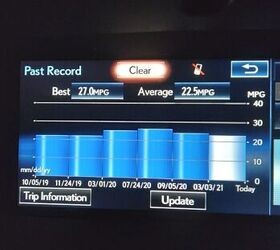The Lexus GS430, a luxury sedan known for its performance and refinement, has garnered a loyal following over the years. This review delves into a long-term ownership experience with a 2015 Lexus GS 350, offering insights into its driving dynamics, comfort, features, and fuel efficiency. While not a GS430, the GS350 shares the same platform and many similar characteristics, providing valuable context for potential GS430 buyers.
Over two years of ownership, the GS 350 has accumulated just over 5,000 miles, primarily due to a shift to remote work. This limited mileage, however, has provided ample opportunity to assess its strengths and weaknesses in various driving conditions.
On-Road Performance and Refinement
The GS excels on the highway, delivering a quiet and comfortable ride thanks to extensive seals and well-insulated cabin. The seats provide ample support for long journeys, and the car maintains a composed demeanor even at higher speeds. The feeling of speed is often deceiving, making highway cruising a relaxed experience.
The non-Levinson audio system provides a good listening experience, though the lack of Apple CarPlay and Android Auto, a common omission in Lexus models of this era, is a notable drawback. The Lexus mouse-based infotainment system, while functional, can be frustrating to use, with occasional overshooting of intended icons.
Interior Quality and Comfort
The interior of the GS boasts high-quality materials, with padded, stitched, and lined surfaces throughout. Squeaks and rattles are minimal, reflecting the solid build quality. While front passengers enjoy ample space and comfort, rear legroom can be limited for taller individuals, especially behind a tall driver. Headroom in the rear is also somewhat restricted, a common trait in modern sedans.
Driving Dynamics and Performance: A Mixed Bag
On winding roads, the GS demonstrates competent handling with accurate steering, strong brakes, and a well-controlled suspension. However, its size and weight become more apparent, requiring a more cautious approach through tighter corners. While the 3.5L V6 engine provides sufficient power for everyday driving, it can feel somewhat lacking when pushed hard. The transmission performs well in automatic mode, and the solid metal paddle shifters allow for manual control, but the overall power delivery lacks the punch of a true sports sedan.
The Sport mode enhances throttle response, steering feel, and shift patterns, but it feels somewhat artificial and doesn’t fundamentally alter the car’s character.
Fuel Economy and Maintenance
Fuel economy in mixed driving conditions averages around 22.5 mpg. The relatively small 17.4-gallon fuel tank limits the cruising range, which could be improved with a larger capacity. Maintenance has been trouble-free, with only routine tasks required.
In conclusion, the Lexus GS 350 provides a comfortable and refined driving experience, particularly suited for highway cruising. While not a true sports sedan, it offers competent handling and a well-appointed interior. Potential buyers seeking a powerful and engaging driving experience might find the engine lacking, but those prioritizing comfort, refinement, and reliability will find the GS a compelling choice. The insights gleaned from this GS 350 review can be helpful for those considering a Lexus GS430, given the shared platform and similar characteristics.


